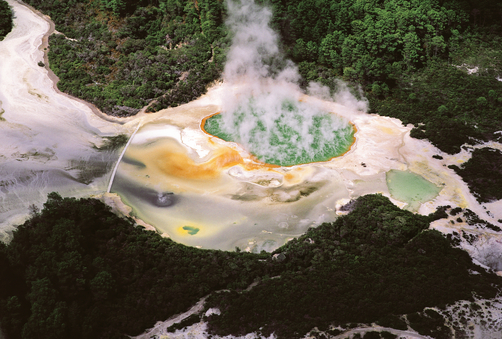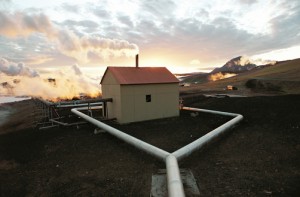People & Research

s9.ac-13
The group’s emphasis on energy and the environment focuses on several broad areas:
- Geothermal energy recovery and utilization
- Carbon sequestration in geologic media
- Fossil fuel reservoirs, recovery, conversion, and upgrading
- Waste remediation and treatment
- Clean processing and green chemistry
Thermal spallation of rock using supercritical water
- Researchers: Adam Carr, Sean Hillson
- Principal Investigator: Jefferson Tester
- An obstacle hindering implementation of EGS is the large up-front capital costs for drilling and reservoir stimulation. For EGS to become more economically viable, particularly in low grade regions, new drilling technologies such as hydrothermal jet drilling are being developed that could significantly reduce the cost to drill the deeper wells needed for low-grade EGS. Hydrothermal flame drills create a jet of supercritical water which impacts and heats the rock, causing the rock to “spall”, i.e., eject small rock fragments to relieve thermal and mechanical stress. Hydrothermal drilling has the potential to lower drilling costs over conventional methods by increasing penetration rates and avoiding the transit time associated with replacing worn drill bits and transporting the drill string out of the well.
Although focused on experimental studies, the project has also theoretical part in parallel. The drilling rates will be measured by analyzing reactor exit stream chemical compositions, reactor temperature distributions and remnant rock properties. In order to understand drilling mechanics, models of the different chemical processes occurring in the reactor will be made from the current state of the art, and reconciled to experimental results. The developed models will take into account transport of rock spalls in the wellbore and heat transfer effects throughout the process. The research conducted in this project will hopefully lead to an increased understanding of the mechanisms of rock spallation/dissolution, as well as demonstrate the commercial viability of a novel drilling method.
Modeling of transient heat transfer in geothermal reservoirs
- Researchers: Don Fox
- Principal Investigator: Jefferson Tester
- An Engineered Geothermal System (EGS) can be depleted of its thermal energy after a prolonged draw down period, putting into question the renewability of conductively dominated EGS reservoirs. However, the EGS reservoir will recover a portion of its “farmed” energy if it is left unused. Because heat conduction from the surrounding hot far field rock is slow, the recovery time scale can be between 2-5 times the time scale of extraction. For strategic use of a geothermal reservoir, appropriate modeling of the transient heat transfer within the reservoir is needed. With the appropriate models, a sustainable system of geothermal reservoirs can be implemented such that each single reservoir is allowed to recover long enough before it is used again. Under this operational strategy, the above surface infrastructure’s capacity factor is minimally effected by reservoir depletion and recovery phases. Reservoir modeling is performed using the TOUGH2 numerical code along with a front end program called PetraSim.
Another area of importance in reservoir modeling is thermal hydraulic mapping of EGS reservoirs using tracers. Thermal hydraulic mapping can elucidate information of the flow paths, configuration of fractures, and how the fractures thermally interact.
System analysis of innovative geothermal resources
- Researchers: Maciej Lukawski
- Principal Investigator: Jefferson Tester
- In 2006, an MIT-led interdisciplinary panel conducted the study “The Future of Geothermal Energy” in which they estimated that the U.S. geothermal resource base to 10km depth is of the order of 14 million EJ. More importantly, they expected the recoverable resource to be at least 0.28 million EJ, which greatly exceeds the current annual U.S. primary energy demand of approximately 100 EJ. However, the major fraction of this resource is stored in geological formations that lack either sufficient permeability, a fluid present in the pores and fractures, or both. Such geothermal resources, which are not commercially developed yet, are known as Enhanced Geothermal Systems (EGS).
The geographic distribution of the geothermal resources in the U.S. is uneven. The eastern part of the country is characterized by geothermal resources, that although quantitatively sufficient, are stored at greater depth to those available in the western U.S. Due to exponential increase in the cost of drilling with depth, the current drilling techniques favor “low-grade” geothermal resources in the eastern half of the country. Low resource temperatures, it turn, indicate a low conversion efficiency of thermal energy to electricity. This promotes direct use applications and co-generation of electricity and heat.
One goal of our project is to determine the viability of both heat and electricity production from low-grade geothermal resources in the Northeastern United States. Our research involves a techno-economic analysis of innovative uses of geothermal-produced fluids and their potential as an alternative to consumption of depletable fossil fuels. These include direct use of geothermal resources as well as hybrid biomass-geothermal combined heat and power (CHP) plants. In the first phase, our analysis focuses on the implementation of this approach on the Cornell campus. In the second phase, we will generalize this analysis and expand it to other distributed users such as campuses, industrial parks, towns and communities. Large part of this project is done with our collaborators at West Virginia University, Iowa State University and National Renewable Energy Laboratory, whose efforts are led by Prof. Brian Anderson, Prof. Terrence Meyer and Dr. Chad Augustine.


